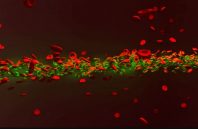New photonic tools for medical imaging can be used to understand the nonlinear behavior of laser light in human blood for theranostic applications. When light enters biological fluids it is quickly scattered, however, some cell suspensions can induce nonlinear responses in laser beams to self-focus and enhance the penetration of light for biomedical applications as a quantifiable marker of disease.
In a recent study now published in Light: Science and Applications, Rekha Gautam and her colleagues at the San Francisco State University and an international team of co-workers showed that a laser beam shining through red blood cell suspensions could become “self-trapped.” The process reduced light scattering to retain the power of the beam of laser light within the biological samples.
The observed nonlinearity depended on osmotic conditions and the age of the samples. The scientists propose using the technique to diagnose sickle cell anemia or malaria; diseases which impact the size and shape of blood cells.

 (585) 768-2513
(585) 768-2513

